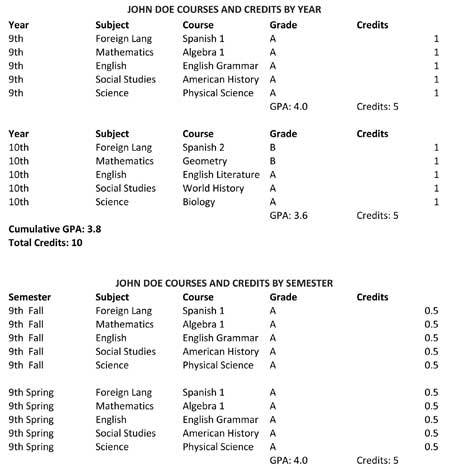A high school diploma is simply a piece of paper. For colleges and universities, proof of graduation is the transcript that indicates which courses were completed, when, and what grade was earned. To make sure your transcripts are adequate, you’ll need to include the right information.
Colleges and universities may require you to put transcripts into a specific format, such as a spreadsheet. Usually schools want to see a breakdown of courses in a semester-by-semester format. They may require that you send the transcripts via regular mail or the school may prefer an e-mailed copy. Some schools may request an official copy with the “school administrator’s” signature and a notary stamp. Again, it’s important to contact the school(s) to determine any requirements.
At a minimum, the following information should be easy to identify on your transcripts:
- Student’s full name (and probably social security number too)
- School name, address, and phone number
- Name of the “official” submitting the transcripts
- Years of attendance, indicating each grade level by year(s)
- Courses (by name) that were completed—by year, semester, or grade level based on the school’s preferences
- Grade earned for each course
- Credits awarded for each course
- Graduation date and statement of completion
If a child earned credits from another school, such as from a college or university, you will want to note these courses, credits, and grades on the transcript as well. You will probably also have to request official transcripts from the college your child attended, which will be then sent directly to the new college or university.
It may be necessary to break the transcript information down into semesters (fall and spring) if a school requires it. Additionally, some schools may want to see the following:
- The total credits for each year
- The GPA (grade point average) for each year
- A running total of credits
- The overall GPA
The goal is to make it easy for schools to get the information they need from your transcripts. Remember, school admission counselors have to review the information provided to complete paperwork for their records. It’s for your child’s benefit that you make it easy for counselors to get what they need from the transcripts—to this end, schools may have you “transfer” the transcript information to their preferred credit-summary form.
Sample transcript format
Here you’ll find some sample formats you might want to use for your homeschool transcripts. Although only one or two years are listed, you should include all of your child’s years in high school. Different views of the course breakdown are provided as examples; however, schools will usually want to see only one view to avoid confusion.
OFFICIAL TRANSCRIPTS—DOE HOMESCHOOL HIGH SCHOOL
Student’s Name: John J. Doe
Social Security Number: XXX-XX-XXXX
School Name: Doe Homeschool
School Address: 123 Main Street
School Phone Number: 555-555-9876
School Contact Person and Position: Jane Doe, Principal
Years of Attendance:
- 9th Grade: 1999–2000
- 10th Grade: 2000–2001
- 11th Grade: 2001–2002
- 12th Grade: 2002–2003
Graduation Date: May 28, 2003
Statement of Completion: John Doe successfully completed the requirements of Doe homeschool and was awarded a high school diploma on May 28, 2003.
JOHN DOE—COURSES AND CREDITS BY SUBJECT
English Credits: 5
English Grammar: 1 credit
English Literature: 1 credit
American Literature I: 1 credit
American Literature II: 1 credit
Creative Writing and Poetry: 1/2 credit
Journalism I: 1/2 credit
Mathematics Credits: 4
Algebra I: 1 credit
Geometry: 1 credit
Algebra II: 1 credit
Trigonometry: 1 credit
Social Science Credits: 4
American History: 1 credit
World History: 1 credit
American Government: 1 credit
World Studies: 1 credit
Natural Science Credits: 5
Physical Science: 1 credit
Biology: 1 credit
Biology Lab: 1/2 credit
Chemistry: 1 credit
Chemistry Lab: 1/2 credit
Physics: 1 credit
Foreign Language Credits: 2
Spanish I: 1 credit
Spanish II: 1 credit
Total Credits: 20

Transcript proof
Most public, private, and parochial high schools within a state follow a conventional standard for their curricula that is recognized or at least accepted at face value by many colleges and universities because the curricula is usually regulated by the state’s educational department. When college or university counselors see Algebra I, American History, Journalism, or Spanish II (for example) listed on a transcript from a private, public, or parochial school, they assume the course has met the school’s admission requirements. They don’t require additional information to indicate what was taught for each subject or how the student earned the grade for each subject.
However, since homeschools are unconventional in nature, colleges and universities may need help understanding the scope and sequence of the courses a student completed, as well as help with understanding how a student fulfilled the requirements of the course. This is when detailed record keeping benefits both you and your child.
Again, check with each school to determine what they want or need to be certain you are keeping the correct breadth and depth of records. In general, it is better to have more information available to provide a college or university rather than too little information. It is also easier to keep track of this information as your child progresses through high school rather than trying to remember all of it at the end of her senior year.



